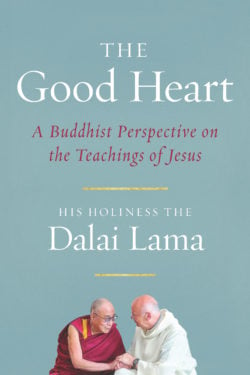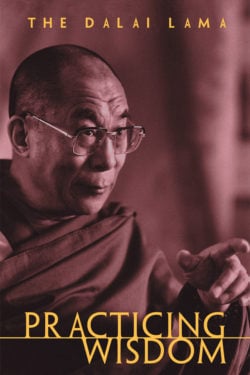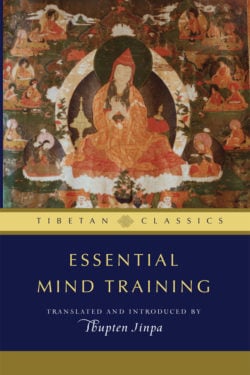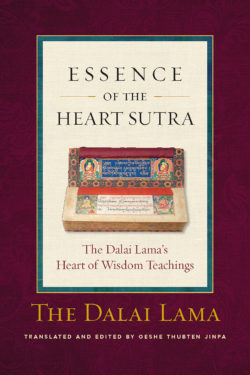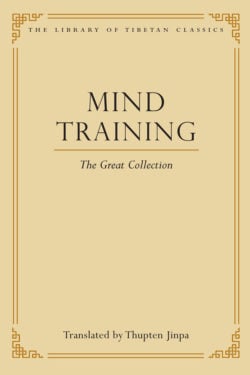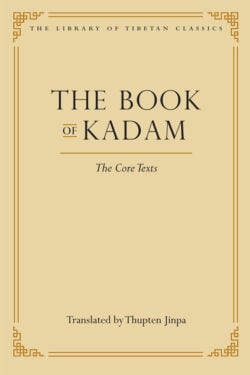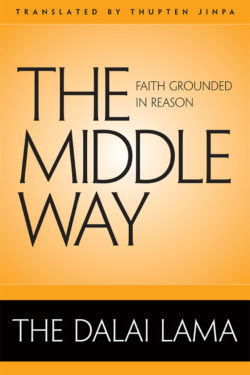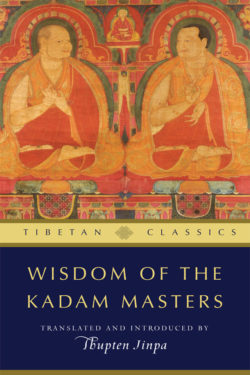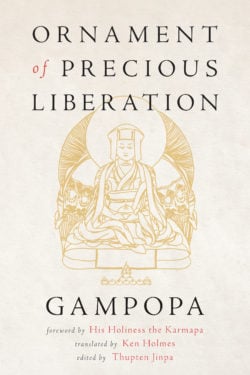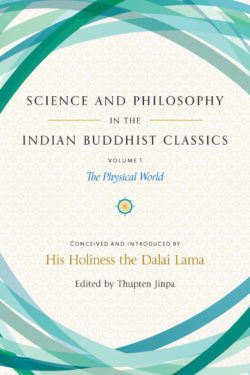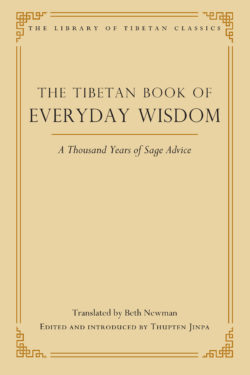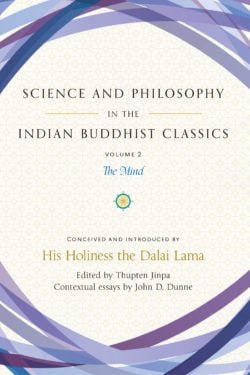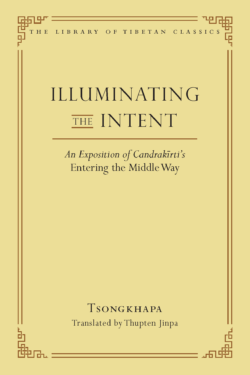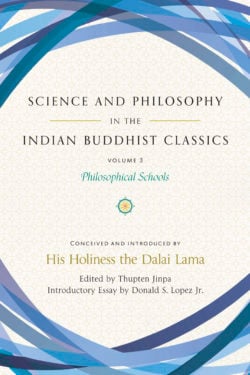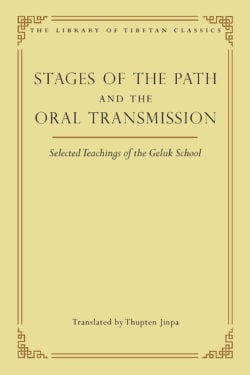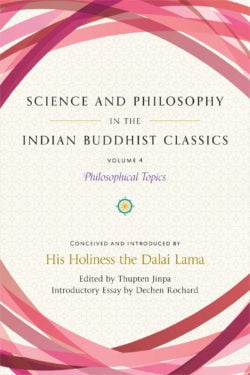Thupten Jinpa

Thupten Jinpa Langri was educated in the classical Tibetan monastic academia and received the highest academic degree of Geshe Lharam (equivalent to a doctorate in divinity). Jinpa also holds a BA in philosophy and a PhD in religious studies, both from the University of Cambridge, England. Since 1985, he has been the principal translator to the Dalai Lama, accompanying him to the United States, Canada, and Europe. He has translated and edited many books by the Dalai Lama, including The World of Tibetan Buddhism, Essence of the Heart Sutra, and the New York Times bestseller Ethics for the New Millennium.
Jinpa has published scholarly articles on various aspects of Tibetan culture, Buddhism, and philosophy, and books such as Songs of Spiritual Experience: Tibetan Poems of Awakening and Insight (co-authored) and Self, Reality and Reason in Tibetan Thought. He serves on the advisory board of numerous educational and cultural organizations in North America, Europe, and India. He is currently the president and the editor-in-chief of the Institute of Tibetan Classics, a nonprofit educational organization dedicated to translating key Tibetan classics into contemporary languages. And he also currently chairs the Mind and Life Institute and the Compassion Institute.
Books, Courses & Podcasts
The Good Heart
In The Good Heart, the Dalai Lama provides an extraordinary Buddhist perspective on the teachings of Jesus. His Holiness comments on well-known passages from the four Christian Gospels, including the Sermon on the Mount, the parable of the mustard seed, the Resurrection, and others. Drawing parallels between Jesus and the Buddha—and the rich traditions from which they hail—the Dalai Lama delivers a profound affirmation of the sacred in all religions. Readers will be uplifted by the exploration of each tradition’s endless merits and the common humanity they share.
Practicing Wisdom
Like the bestselling A Flash of Lightning in the Dark of the Night, Practicing Wisdom focuses on Shantideva’s Way of the Bodhisattva. While the former includes only a brief introduction to Shantideva’s complex and crucial ninth chapter on insight, Practicing Wisdom is a full and detailed follow-up commentary, making it an invaluable statement on the fundamental concept behind Buddhist thought and practice.
Shantideva says in his Guide to the Bodhisattva Way of Life: “All branches of the Buddha’s teachings are taught for the sake of wisdom. If you wish to bring an end to suffering, you must develop wisdom.” Shantideva’s ninth chapter is revered in Tibetan Buddhist circles as one of the most authoritative expositions of the Buddha’s core insight, and all other Buddhist practices are means to support the generation of this wisdom within the practitioner. In Practicing Wisdom, the Dalai Lama reaffirms his reputation as a great scholar, communicator, and embodiment of the Buddha’s Way by illuminating Shantideva’s verses, drawing on contrasting commentaries from the Nyingma and Gelug lineages, and leading the reader through the stages of insight up to the highest view of emptiness. These teachings, delivered in southern France in 1993, have been masterfully translated, edited, and annotated by Geshe Thupten Jinpa, the Dalai Lama’s primary translator and founder of the Institute of Tibetan Classics.
Essential Mind Training
The key to happiness is not the eradication of all problems but rather the development of a mind capable of transforming any problem into a cause of happiness. Essential Mind Training is full of guidance for cultivating new mental habits for mastering our thoughts and emotions.
This volume contains eighteen individual works selected from Mind Training: The Great Collection, the earliest compilation of mind-training (lojong) literature. The first volume of the historic Tibetan Classics series, Essential Mind Training includes both lesser-known and renowned classics such as Eight Verses on Mind Training and The Seven-Point Mind Training. These texts offer methods for practicing the golden rule of learning to love your neighbor as yourself and are full of practical and down-to-earth advice.
The techniques explained here, by enhancing our capacity for compassion, love, and perseverance, can give us the freedom to embrace the world.
Read the biographies of Chekawa Yeshe Dorje and Atisha at the Treasury of Lives.
Essence of the Heart Sutra
For more than two thousand years, the Heart Sutra has been part of the daily life of millions of Buddhists. This concise text, so rich and laden with meaning, concentrates the very heart of Buddhism into a powerful and evocative teaching on the interdependence of all reality.
In Essence of the Heart Sutra, the Dalai Lama masterfully unpacks the Heart Sutra so that any reader can benefit from its teachings—teachings meant to help us release ourselves from suffering and live with true compassion. Comprised of his “Heart of Wisdom” talks, originally delivered to thousands of listeners in 2001, the book offers the Dalai Lama’s commentary as well as his easy-to-follow overview of Buddhist philosophy that places the sutra within its historical and philosophical context. With additional contributions by scholar and translator Thupten Jinpa, Essence of the Heart Sutra is the authoritative presentation of a text seminal to the world’s religious heritage.
Mind Training
Compiled in the fifteenth century, Mind Training: The Great Collection is the earliest anthology of a special genre of Tibetan literature known as “mind training,” or lojong in Tibetan. The principal focus of these texts is the systematic cultivation of such altruistic thoughts and emotions as compassion, love, forbearance, and perseverance. The mind-training teachings are highly revered by the Tibetan people for their pragmatism and down-to-earth advice on coping with the various challenges and hardships that unavoidably characterize everyday human existence.
The volume contains forty-four individual texts, including the most important works of the mind training cycle, such as Serlingpa’s well-known Leveling Out All Preconceptions, Atisha’s Bodhisattva’s Jewel Garland, Langri Thangpa’s Eight Verses on Training the Mind, and Chekawa’s Seven-Point Mind Training together with the earliest commentaries on these seminal texts. An accurate and lyrical translation of these texts, many of which are in metered verse, marks an important contribution to the world’s literary heritage, enriching its spiritual resources.
Learn more about the Library of Tibetan Classics
Learn about becoming a benefactor of the Library of Tibetan Classics
Read the biographies of the following masters at the Treasury of Lives:
The Book of Kadam
The Kadam school of Tibetan Buddhism emerged in the eleventh century from the teachings of the Indian master Atiśa and his principal Tibetan student, Dromtönpa. Although it no longer exists as an independent school, Kadam’s teachings were incorporated into the four major schools of Tibetan Buddhism and are still prized today for their unique practical application of the bodhisattva’s altruistic ideal in everyday life. One of the most cherished teachings stemming from Atiśa and Dromtönpa is the collection of esoteric oral transmissions enshrined in The Book of Kadam. This volume includes the core texts of the Book of Kadam, notably the twenty-three-chapter dialogue between Atiśa and Dromtönpa that is woven around Atiśa’s Bodhisattva’s Jewel Garland, as well as complementary texts that illuminate the history and practices of the Kadam tradition.
Learn more about the Library of Tibetan Classics
Learn about becoming a benefactor of the Library of Tibetan Classics
Read the biographies of the following masters at the Treasury of Lives:
The Middle Way
The Dalai Lama opens The Middle Way with an elegant argument for the power of compassion in cultivating a happy life. From there, he connects core ideas of Buddhist philosophy to the truths of our shared condition. His Holiness delivers a sparklingly clear teaching on how the Buddhist ideas of emptiness and interdependency relate to personal experience and bring a deeper understanding of the world around us.
In down-to-earth style, His Holiness sets forth a comprehensive explanation of the Mahayana tradition based on two of Buddhism’s most revered figures and their renowned works: Nagarjuna’s Middle Way and Tsongkhapa’s Three Principal Aspects of the Path. Both works are rooted in the ancient Indian scholastic tradition of Nalanda Monastery, which approached Buddhism not just through faith and devotion, but through critical inquiry.
Through these beautifully complementary teachings, His Holiness urges us to strive “with an objective mind, endowed with a curious skepticism, to engage in careful analysis and seek the reasons behind our beliefs,” for only faith grounded in reason is truly unshakable.
Read Tsongkhapa’s biography at the Treasury of Lives.
Wisdom of the Kadam Masters
The phrase “Kadam masters” evokes for many Tibetans a sense of a spiritual golden age—the image of a community of wise yet simple monks devoted to a life of mental cultivation. These eleventh- and twelfth-century masters were particularly famed for their pithy spiritual sayings that captured essential teachings in digestible bites. In these sayings one unmistakably detects a clear understanding of what comprises a truly happy life, one that is grounded in a deep concern for the welfare of others.
Like the Sayings of the Desert Fathers, Lao Tzu, or Rumi, the teachings contained in Wisdom of the Kadam Masters can be approached as a part of the wisdom heritage of mankind, representative of the long history of the long human quest to understand our existence and its meaning. This volume offers some of the most beloved teachings of the Tibetan tradition.
Learn more about the following masters at the Treasury of Lives:
Ornament of Precious Liberation
Discover the heart of the Buddha’s teachings in this new and beautiful translation of Gampopa’s classic guidebook.
Ornament of Precious Liberation is a spiritual and literary treasure of Tibetan Buddhism and of the Kagyü lineage in particular. Laying out step-by-step the path to buddhahood that is open to us all, to read Gampopa’s text is like receiving the teachings directly from the master himself.
It is a quintessential guide to enlightenment that students will return to again and again for its insights into living an awakened life.
Science and Philosophy in the Indian Buddhist Classics, Vol. 1
Under the visionary supervision of His Holiness the Dalai Lama, Science and Philosophy in the Indian Buddhist Classics brings together classical Buddhist explorations of the nature of our material world and the human mind and puts them into context for the modern reader. It is the Dalai Lama’s view that the explorations by the great masters of northern India in the first millennium CE still have much that is of interest today, whether we are Buddhist or not.
Volume 1, The Physical World, explores the nature of our material world—from the macroscopic to the microscopic. It begins with an overview of the many frameworks, such as the so-called five aggregates, that Buddhist thinkers have used to examine the nature and scope of reality. Topics include sources of knowledge, the scope of reason, the nature and constituents of the material world, theories of the atom, the nature of time, the formation of the universe, and the evolution of life, including a detailed explanation of the early Buddhist theories on fetal development. The volume even contains a brief presentation on early theories about the structure and function of the brain and the role of microorganisms inside the human body. The book weaves together passages from the works of great Buddhist thinkers such as Asaṅga, Vasubandhu, Nāgārjuna, Dignāga, and Dharmakīrti. Each of the major topics is introduced by Thupten Jinpa, the Dalai Lama’s principal English-language translator and founder of the Institute of Tibetan Classics.
Explore the entire series here.
The Tibetan Book of Everyday Wisdom
The Tibetan Book of Everyday Wisdom: A Thousand Years of Sage Advice presents a genre of Tibetan works known as “wise sayings” (lekshé). While most Tibetan literature focuses on the Buddhist path, wise sayings literature has traditionally been a centerpiece of secular education in Tibet and in the cultivation of social mores and an honorable way of life. Drawing inspiration from classical Indian literature on human virtue and governance (nitisastra), including the folktales in the Pañcatantra, the authors of these Tibetan works strove to educate young minds in the ways of the civilized world, especially by distinguishing the conduct of the wise from that of the foolish.
This anthology includes some of the best-loved classics of Tibetan literature, such as Sakya Pandita’s Jewel Treasury of Wise Sayings, Panchen Sönam Drakpa’s Ganden Wise Sayings, and Gungthang’s Treatise on Trees and Treatise on Water. The final work is the intriguing Kaché Phalu’s Advice. Ostensibly written by a wise Tibetan Muslim, this versified text enjoys great popularity within Tibetan-speaking communities, such that many Tibetans are able to recite at least a few verses from memory.
Learn more about the Library of Tibetan Classics
Learn about becoming a benefactor of the Library of Tibetan Classics
Science and Philosophy in the Indian Buddhist Classics, Vol. 2
This, the second volume in the Science and Philosophy in the Indian Buddhist Classics series, focuses on the science of mind. Readers are first introduced to Buddhist conceptions of mind and consciousness and then led through traditional presentations of mental phenomena to reveal a Buddhist vision of the inner world with fascinating implications for the contemporary disciplines of cognitive science, psychology, emotion research, and philosophy of mind. Major topics include:
- The distinction between sensory and conceptual processes and the pan-Indian notion of mental consciousness
- Mental factors—specific mental states such as attention, mindfulness, and compassion—and how they relate to one another
- The unique tantric theory of subtle levels of consciousness, their connection to the subtle energies, or “winds,” that flow through channels in the human body, and what happens to each when the body and mind dissolve at the time of death
- The seven types of mental states and how they impact the process of perception
- Styles of reasoning, which Buddhists understand as a valid avenue for acquiring sound knowledge
In the final section, the volume offers what might be called Buddhist contemplative science, a presentation of the classical Buddhist understanding of the psychology behind meditation and other forms of mental training.
To present these specific ideas and their rationale, the volume weaves together passages from the works of great Buddhist thinkers like Asaṅga, Vasubandhu, Nāgārjuna, Dignāga, and Dharmakīrti. His Holiness the Dalai Lama’s introduction outlines scientific and philosophical thinking in the history of the Buddhist tradition. To provide additional context for Western readers, each of the six major topics is introduced with an essay by John D. Dunne, distinguished professor of Buddhist philosophy and contemplative practice at the University of Wisconsin. These essays connect the traditional material to contemporary debates and Western parallels, and provide helpful suggestions for further reading.
Explore the entire series here.
Illuminating the Intent
This work is perhaps the most influential explanation of Candrakirti’s seventh-century classic Entering the Middle Way (Madhyamakavatara).
Written as a supplement to Nagarjuna’s Fundamental Verses on the Middle Way, Candrakirti’s text integrates the central insight of Nagarjuna’s thought—the rejection of any metaphysical notion of intrinsic existence—with the well-known Mahayana framework of the ten levels of the bodhisattva, and it became the most studied presentation of Madhyamaka thought in Tibet.
Completed the year before the author’s death, Tsongkhapa’s exposition of Candrakirti’s text is recognized by the Tibetan tradition as the final standpoint of Tsongkhapa on many philosophical questions, particularly the clear distinctions it draws between the standpoints of the Madhyamaka and Cittamatra schools.
Written in exemplary Tibetan, Tsongkhapa’s work presents a wonderful marriage of rigorous Madhyamaka philosophical analysis with a detailed and subtle account of the progressively advancing mental states and spiritual maturity realized by sincere Madhyamaka practitioners.
The work remains the principal textbook for the study of Indian Madhyamaka philosophy in many Tibetan monastic colleges, and it is a principal source for many Tibetan teachers seeking to convey the intricacies of Madhyamaka philosophy to non-Tibetan audiences.
Though it is often cited and well known, this is the first full translation of this key work in a Western language.
Learn more about the Library of Tibetan Classics
Learn about becoming a benefactor of the Library of Tibetan Classics
Science and Philosophy in the Indian Buddhist Classics, Vol. 3
Deepen your understanding of meaning and truth with the third volume of the Dalai Lama’s esteemed series Science and Philosophy in the Indian Buddhist Classics.
In this third volume the focus turns to exploring the philosophical schools of India. The practice of presenting the views of various schools of philosophy dates back to the first millennium in India, when proponents of competing traditions would arrange the diverse sets of philosophical positions in a hierarchy culminating in their own school’s superior tenets. Centuries later, relying on the Indian Buddhist treatises, Tibet developed its own tradition of works on tenets (grub mtha’), often centered on the four schools of Buddhist philosophy, using them to demonstrate the philosophical evolution within their own tradition, and within individual practitioners, as they progressed through increasingly more subtle expressions of the true reality.
The present work follows in this venerable tradition, but with a modern twist. Like its predecessors, it presents the views of seven non-Buddhist schools, those of the Samkhya, Vaisesika, Nyaya, Mimamsa, Vedanta, Jaina, and Lokayata, followed by the Buddhist Vaibhasika, Sautrantika, Cittamatra, and Madhyamaka schools, arranging them like steps on a ladder to the profound. But rather than following in the sharply polemical approach of its ancient predecessors, it strives to survey each tradition authentically, relying on and citing the texts sacred to each, allowing the different traditions to speak for themselves. What, it asks, are the basic components of the world we experience? What is the nature of their ultimate reality? And how can we come to experience that for ourselves? See how the rich spiritual traditions of India approached these key questions, where they agreed, and how they evolved through dialogue and debate.
This presentation of philosophical schools is introduced by His Holiness and is accompanied by an extensive introduction and survey by Professor Donald Lopez Jr. of the University of Michigan, who is uniquely qualified to communicate the scope and significance of this literary and spiritual heritage to modern readers.
Explore the entire series here.
Stages of the Path and the Oral Transmission
A major contribution to the literature on Buddhist practice according to the Geluk school of Tibetan Buddhism from its foremost interpreter.
Although it was the last major school to emerge in the Tibetan Buddhist tradition, the Geluk school has left an indelible mark on Buddhist thought and practice. The intellectual and spiritual brilliance of its founder, the great Tsongkhapa (1357–1419), has inspired generations of scholars and tantric yogis to place him at the heart of their daily meditative practice. The Geluk tradition’s close ties to the Dalai Lamas have also afforded it an outsized influence in all aspects of Tibetan life for centuries. At its peak, its combined monasteries boasted a population in the tens of thousands, and its sway encompassed the religious landscape of Mongolia and much of Central Asia.
This widespread religious activity fostered a rich literary tradition, and fifteen seminal works are featured here representing four genres of that tradition. The first are works on the stages of the path, or lamrim, the genre for which the Geluk is most renowned. Second are works on guru yoga, centered around the core Geluk ritual Offering to the Guru (Lama Chöpa). Third are teachings from the unique oral transmission of Geluk mahāmudrā, meditation on the nature of mind. Fourth are the “guide to the view” (tatri) instructions. The volume features well-known authors like Tsongkhapa, the First Panchen Lama, and the Fifth Dalai Lama, but also important works from lesser-known figures like Gomchen Ngawang Drakpa’s stages of the path in verse and Gyalrong Tsultrim Nyima’s extensive commentary on the Lama Chöpa that interweaves precious explanations from the Ensa Oral Tradition he received from his own teacher.
Your guide to these riches, Thupten Jinpa, maps out their historical context and spiritual significance in his extensive introduction.
Learn more about the Library of Tibetan Classics
Learn about becoming a benefactor of the Library of Tibetan Classics
Science and Philosophy in the Indian Buddhist Classics, Vol. 4
This fourth and final Science and Philosophy in the Indian Buddhist Classics volume provides, through extensive passages, a window into the works of the great thinkers from the flowering of philosophy in classical India.
This is the second philosophy volume in the Science and Philosophy series. Whereas the first philosophy volume presented the views of the non-Buddhist and Buddhist schools in sequence, the present works selects specific topics for consideration, including the nature of the two truths, the analysis of self, the Yogacara explanation of reality, emptiness in the Madhyamaka tradition, a survey of logic and epistemology, and the Buddhist explanation of language and meaning. Like earlier volumes, it provides, through extensive extracts, a window into the works of the masters of the Nalanda tradition. The final section on language is particularly unique and largely crafted by Thupten Jinpa.
Explore the entire series here.

